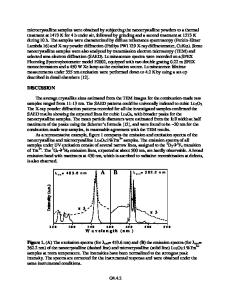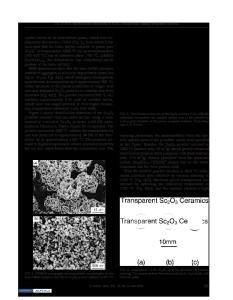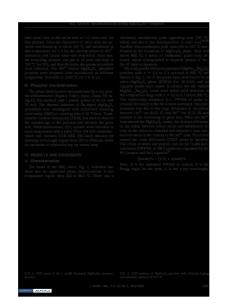Transparent Lu 2 O 3 :Eu Ceramics
- PDF / 967,624 Bytes
- 6 Pages / 432 x 648 pts Page_size
- 30 Downloads / 424 Views
Transparent Lu2O3:Eu Ceramics Zachary M. Seeley, Joshua D. Kuntz, Nerine J. Cherepy, and Stephen A. Payne Chemical Sciences Division, Lawrence Livermore National Laboratory, Livermore, CA 945509698, U.S.A. ABSTRACT We are developing highly transparent ceramic oxide scintillators for high energy (MeV) radiography screens. Lutetium oxide doped with europium (Lu2O3:Eu) is the material of choice due to its high light yield and stopping power. As an alternative to hot-pressing, we are utilizing vacuum sintering followed by hot isostatic pressing (HIP). Nano-scale starting powder was uniaxially pressed into compacts and then sintered under high vacuum, followed by HIP’ing. Vacuum sintering temperature proved to be a critical parameter in order to obtain highly transparent Lu2O3:Eu. Under-sintering resulted in open porosity disabling the driving force for densification during HIP’ing, while over-sintering lead to trapped pores in the Lu2O3:Eu grain interiors. Optimal vacuum sintering conditions allowed the pores to remain mobile during the subsequent HIP’ing step which provided enough pressure to close the pores completely resulting in fully-dense highly transparent ceramics. Currently, we have produced 3 mm thick by 4.5 cm diameter ceramics with excellent transparency, and anticipate scaling to larger sizes while maintaining comparable optical properties. INTRODUCTION Transparent polycrystalline ceramics have gained significant interest for applications in laser host materials, high index lenses, transparent armor, radiation detectors, and radiography screens [1-5]. They can be formed in a wider range of compositions, sizes, shapes, and at lower cost than single crystals. Transparent ceramics are however limited to cubic crystal structure materials, and optimized processing is necessary to achieve full density and transparency. Lutetium oxide doped with europium (Lu2O3:Eu) has become a material of interest as a scintillating radiography screen due to its high density and x-ray stopping power, efficient conversion to visible light, and visible emission at ~600 nm coupling well with silicon CCDs [6,7]. Due to the high melting point of Lu2O3 (~2400°C), sintering to full density is challenging. Conventionally, hot-pressing overcomes this obstacle by applying pressure and temperature simultaneously [8]. However, along with this technique come a highly reducing environment and potential for contamination from the graphite tooling, requiring a post-treatment anneal which often degrades the transparency. In this work, we have employed the sinter-HIP method to obtain highly transparent Lu2O3. Under this process, the ceramic is vacuum sintered to closed porosity and then subsequently HIP’ed under inert argon gas pressure to full density. This method allows consolidation in a less reducing environment and lower potential for contamination.
3
EXPERIMENT Lu2O3 doped with 5at.% Eu (Lu1.9Eu0.1O3) nanopowder was synthesized via the flame spray pyrolysis (FSP) method by NanoceroxTM (Ann Arbor, MI). As received powder had a specific sur
Data Loading...











